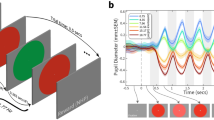Abstract
The pupillary response of male and female subjects to various sexual stimuli was examined. Change in pupil size was compared using light and dark control slides and nude male and female, heterosexual, and homosexual stimulus slides. Attempts were made to control for the many confounds inherent in pupillometric research. Pupil size was measured using video-recording techniques that magnified pupils to an easily measured size. Greater pupil change was found when the stimulus slide was preceded by a relatively lighter control slide. In addition, pupil change was related to familiarity with the stimulus slide and the relative pupil response changed as subjects gained experience with the stimulus material. Explanations and implications for further research are discussed.
Similar content being viewed by others
References
Barlow, J. D. (1970). Pupillary size as an index of preference.Percept. Mot. Skills 31: 331–336.
Bernick, N., Kling, A., and Borowitz, G. (1971). Physiologic differentiation of sexual arousal and anxiety.Psychosom. Med. 33: 341–352.
Birren, J. E., Casperson, R. C., and Botwinick, J. (1951). Pain measurement by the radiant heat method: Individual differences in pain sensitivity, the affects of skin temperature, and stimulus duration.J. Exp. Psychol. 4: 419–424.
Gambill, H. D., Ogle, K. N., and Kearns, T. P. (1967). Mydriatic effect of four drugs determined with pupillography.Arch. Opthalmol. 77: 740–746.
Goldwater, B. C. (1972). Psychological significance of pupillary movements.Psychol. Bull. 77: 340–355.
Good, L. R., and Levine, R. H. (1970). Pupillary responses of repressors and sensitizers to sexual and adversive stimuli.Percept. Mot. Skills 30: 631–634.
Hamel, R. F. (1974). Female subjective and pupillary reaction to nude male and female figures.J. Psychol. 87: 171–175.
Hess, E. H. (1975). The role of pupil size in communication.Sci. Am. 233: 46–54.
Hess, E. H. (1965). Attitude and pupil size.Sci. Am. 212: 46–54.
Hess, E. H., and Polt, J. M. (1960). Pupil size as related to the interest value of visual stimuli.Science 132: 349–350.
Hess, E. H., Seltzer, A., and Shlien, J. M. (1965). Pupil responses of hetero- and homo-sexual males to pictures of men and women: A pilot study.J. Abn. Psychol. 70: 165–168.
Janisse, M. P. (1973). Pupil size and affect: A critical review of the literature since 1960.Can. Psychol. 14: 311–329.
Janisse, M. P. (1977).Pupillometry: The Psychology of the Pupillary Response Hemisphere, Washington, DC.
Lawless, J. C., and Wake, F. R. (1968). Sex differences in pupillary response to visual stimuli.Psychophysiology 5: 568–569.
Metalis, S. A., and Hess, E. H. (1982). Pupillary response/semantic differential scale relationships.J. Res. Pers. 16: 201–216.
Nunally, J. C., Knott, P. D., Duchnowski, A., and Parker, R. (1967). Pupillary response as a general measure of activiation.Percept. Psychophys. 2: 149–155.
Peavler, W. S., and Mclaughlin, J. P. (1967). The question of stimulus content and pupil size.Psychonom. Sci. 8: 505–506.
Scott, T. R., Wells, W. H., Wood, D. Z., and Morgan, D. I. (1967). Pupil response and sexual interest re-examined.J. Clin. Psychol. 23: 433–438.
Simms, T. M. (1967). Pupillary response of male and female subjects to pupillary difference in male and female picture stimuli.Percept. Psychophys. 2: 533–555.
Winer, B. J. (1971).Statistical Principles in Experimental Design McGraw-Hill, New York.
Woodmansee, J. (1966). Methodological problems in pupillographic experiments. Proceedings of the 74th Annual Convention of the American Psychological Association, Vol. 1, pp. 133–134.
Zuckerman, M. (1971). Physiological measures of sexual arousal in the human.Psychol. Bull. 75: 297–329.
Author information
Authors and Affiliations
Rights and permissions
About this article
Cite this article
Garrett, J.C., Harrison, D.W. & Kelly, P.L. Pupillometric assessment of arousal to sexual stimuli: Novelty effects or preference?. Arch Sex Behav 18, 191–201 (1989). https://doi.org/10.1007/BF01543194
Issue Date:
DOI: https://doi.org/10.1007/BF01543194




